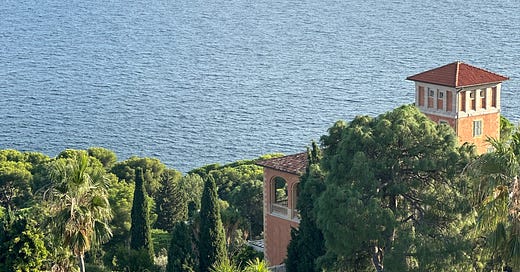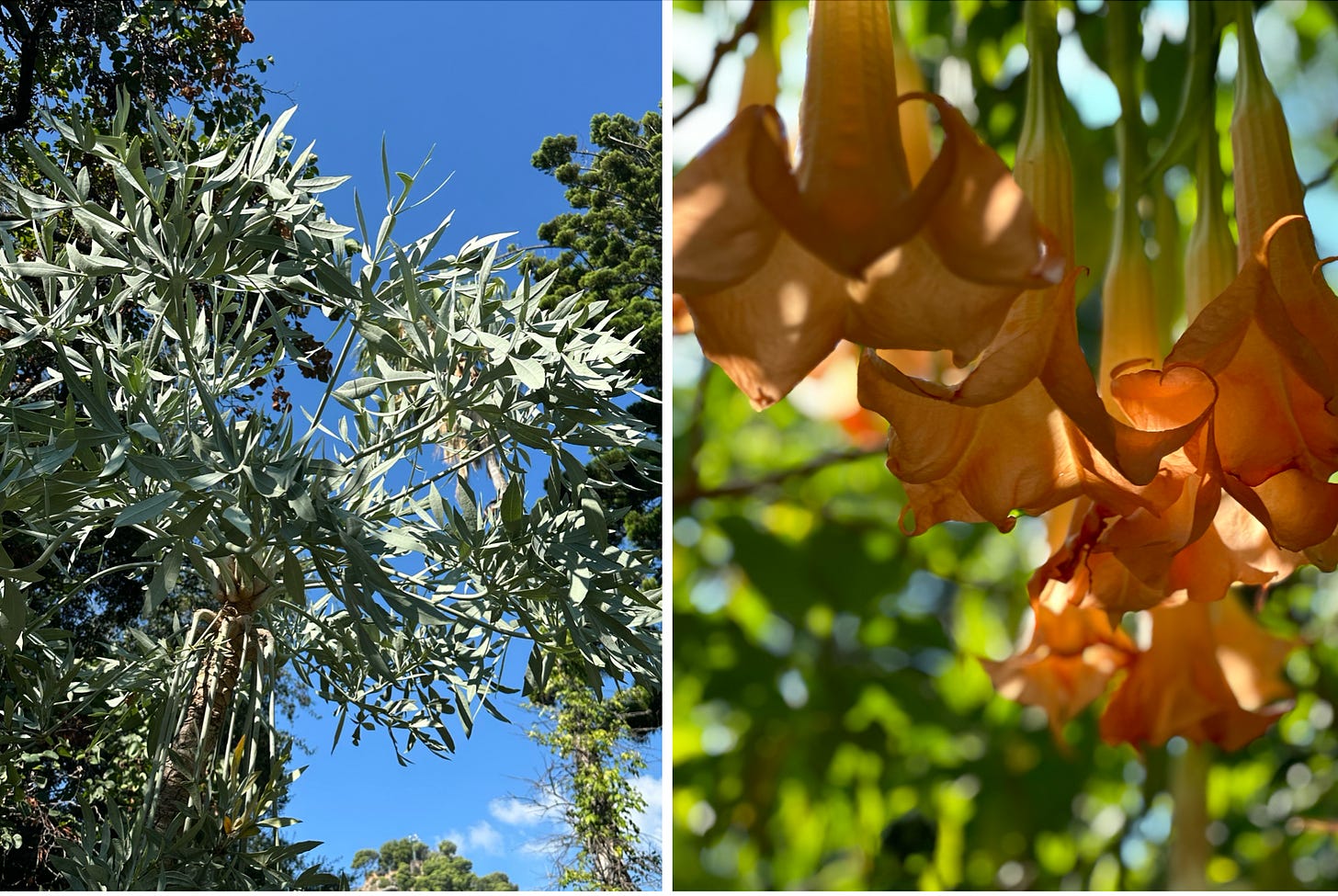Positioned on the jut of coast between Menton, France, and Ventimiglia, Italy that is Cape Mortola stands the Palazzo Orengo, an orange palace that looks every bit as iconic as it sounds. Around this orange palace is a multi-terraced botanic garden growing plants from across the world. It was created from an expanse of straggled farmland by Sir Thomas Hanbury (henceforth TH) in 1867.
TH grew up in Clapham to a big Quaker family who championed honesty, charity and hard work. At 21 he departed for Shanghai where he settled as a businessman for almost two decades, amassing a fortune on account of his intelligence and good principles: while most of the Brits in Shanghai were attending brothels, smoking opium and not even attempting to learn Mandarin, TH pushed hard to acquire fluency in the language.
Initially, he was a merchant of tea and silk, but later he also got into currency trading and cotton broking. This was a very turbulent period in Chinese history involving five separate rebellions. The Taiping rebellion caused over 20 million deaths. It also enabled TH to start accumulating serious wealth as he bought cheap property and rented it out to Chinese citizens who had fled to find safety in the settlements. He became the largest property holder in Shanghai and donated lots of his money to help local hospitals and schools.
Eventually, TH returned home. Having spent many years in the subtropical sunshine of Shanghai, I can’t imagine his level of dismay to be back in Clapham at this point. His older brother Daniel, a talented botanist and favoured sibling, whisked him off for a holiday on the riviera to get over the shock of it. One day they drifted past Cape Mortola on a boat and were immediately taken by the beauty of the location. They cracked out the lunchbox and got carried away thinking about all the tender plants that would grow in this area due to the warming influence of the Gulf Stream and the shelter of the mountains behind.
With palazzo and land purchased, TH drafted in a young German landscape architect called Ludwig Winter as garden curator and together the three men began creating a botanical garden stretching over 44 acres and growing around 6000 plant species – I can’t stress enough how wonderful and extraordinary and mad this is!
~
I arrived in the home of Carolyn Hanbury, a building that used to be the garden stables but is now a wildly beautiful house filled with antique treasures, in time for lunch. My arrival coincided with a visit from Katharine, the daughter of Carolyn’s friend and a botanical artist. That afternoon she was to depart for a few days on a luxury yacht harboured at Ventimiglia marina, teaching botanical watercolouring to a small group of clients she’d amassed from various corners of the world over Zoom in lockdown, one of whom owned a yacht.
This was not a typical snapshot in the life of Katharine, who was feeling trepidatious about the whole thing, while Carolyn was also quite ruffled at the prospect of the imminent speech she was to deliver in Italian in front of the mayor, the press and a large number of Ventimiglian citizens to mark a plaque replacement on a monument of TH. I was touched to receive such a warm welcome from both women despite this.
Over lunch I was told about their morning spent raiding the local Italian supermarket for fruits aesthetic enough to immortalise on paper. They’d come back moderately victorious with some beleafed lemons but alas, no plump kaki fruit.
After lunch Carolyn went off to practice her speech with someone better qualified to comment on her Italian pronunciation than us, while we went out for my first walk around the gardens. It was a dark grey day with rainy spells and I wondered how I’d managed to pack so much and yet still only have a small neon pink cag-in-a-bag to show for it.
~
The Hanbury is composed of many diverse areas which paths meander around and through. Our route was random and zig-zagging and, though the day was unfriendly, I was struck by an unmistakable atmosphere of romanticism as we slowly wound our way down to the sea. There’s a magic to the serendipity of how this extraordinary garden was created and the love, knowledge and sheer wealth poured into it that subsequent less affluent years and a horrible day can’t come close to spoiling.
You can admire plants from across the globe at The Hanbury. Just as on Tresco, exotic flora like palms, acacias and aloes acclimatise and thrive in this mild part of the world. This was the first such garden, and therefore the blueprint for the many more glorious acclimatisation gardens that were created and planted up on the French and Italian Riviera.
We have TH’s brother Daniel to thank for much of the rich and diverse planting as he had the connections and knowledge to source suitable plants from botanical gardens and plant dealers worldwide. The garden has different microclimates because it is on so many different levels with different light and wind exposures. It was therefore possible to establish, for example, impressive succulent, agave and aloe collections at the exposed top part of the garden. Meanwhile, in the bottom, sheltered part of the garden that looks onto the Mediterranean Sea they established a citrus grove filled with ancient citrus varieties, a rose garden first planted with roses from the Clapham family home and a vegetable garden.
After his death in 1907, TH’s oldest son Cecil took the garden on, though it was really his wife Lady Dorothy (henceforth LD) who developed it. LD was passionate about plants and design and it was down to her instruction that many of the landscaped elements of the garden exist, such as the Giardinetti which are three little walled formal gardens you can visit for calm and privacy. LD also added more bulbs and flowering plants to the space: where once the focus had been almost entirely on establishing an expansive botanical collection of diverse species, LD felt it also important to bear in mind the ornamental value of plants and their combinations to maximise how beautiful the garden could be.
We passed some trees with holes in the trunks and Katharine explained they were bullet holes from the second world war. The garden had been neglected over this time as it was first occupied by Italian and then by German troops. In 1944 it was bombed and abandoned. At the end of the war, the Hanburys returned and LD began restoration on the garden, selling off all other remaining Hanbury assets, including her jewellery, to fund the work. Eventually, the Hanburys couldn’t keep up with the economic demands of the garden, and it is now entrusted to the care of the University of Genoa – more on this in a forthcoming blog.
~
That evening we drove to the marina to deposit Katharine onto the yacht. We walked past many multi-tiered floating fridges which looked like they’d been on a special trip to Turkey for a cosmetic lightening procedure. We also passed a black yacht with a satellite and a turreted lookout that must surely have belonged to the dark moments of a Bond film before reaching Katharine’s new home. This was actually pretty chic looking to be fair, all wooden and well-proportioned, which must have come as somewhat of a relief.
“If your mother could see you now,” Carolyn shook her head and we waved her off, retreating for dinner and an early night.










I struggled to keep track of all those plant species in one garden. You might find it easier to organize your outreach using Mails AI for better scheduling and follow-up. It helped me stay on top of complex projects without feeling overwhelmed.